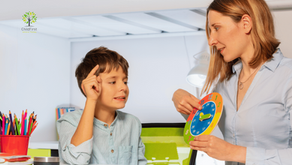Understanding Autism Masking: Is it Beneficial for Children to Conceal their Behaviors?
- ChildFirst Behavior Therapy
- Oct 19, 2023
- 6 min read
Updated: Dec 12, 2023

However, one aspect of autism that is receiving growing attention is masking, especially in children.
Masking refers to the practice of concealing one's autistic traits, behaviors, and characteristics in social settings to fit in and appear "typical."
While this coping mechanism might help individuals with autism navigate social situations more efficiently, it raises crucial questions about the potential benefits and drawbacks, especially when considering children.
This article explores the concept of masking in autism and investigates whether it is beneficial for children to conceal their behaviors.
Autism and Masking
Before delving into the topic of masking, it is essential to comprehend the basics of autism.
Autism, or Autism Spectrum Disorder (ASD), is a developmental condition that affects how individuals perceive the world and interact with others.
It encompasses a wide range of abilities and challenges, which is called a "spectrum."
While no two individuals with autism are exactly alike, common characteristics include difficulties in social interaction, communication deficits, and repetitive or restrictive behaviors.
Masking, in the context of autism, refers to the act of consciously or unconsciously concealing one's autistic traits and behaviors in social situations.
It often involves mimicking or imitating neurotypical behaviors and expressions, suppressing stimming (self-stimulatory behaviors like rocking or hand-flapping), and avoiding conversation about specific interests or obsessions common among autistic individuals.
The primary motivation for masking is to fit in and be accepted, as those who engage in it may have experienced rejection or misunderstandings.
The Origins and Prevalence of Masking
Masking stems from the social pressure to conform and the desire for social acceptance.
Many individuals with autism, particularly children, face challenges in social situations, as they may not intuitively grasp the unwritten rules of social interaction or may have difficulty reading social cues.
This can lead to isolation, exclusion, and the perception that they are "different" from their peers.
Consequently, they may start masking their true selves to bridge the social gap.
The prevalence of masking varies among individuals.
Some children begin masking their autistic traits at a young age, while others may develop masking behaviors as they grow older and become more aware of their differences.
The level of masking can range from subtle adjustments in social behavior to extensive efforts to appear entirely neurotypical.
A significant challenge is that masking can be so ingrained that some individuals may not even recognize they are doing it.
Potential Benefits of Masking for Children with Autism
While masking has its critics, there are arguments in favor of this coping mechanism, particularly for children with autism.
It is essential to recognize that the benefits of masking may vary from one individual to another, but some potential advantages include:
Improved Social Integration: Masking may help children with autism fit in better with their neurotypical peers, reducing the chances of social exclusion and bullying.
Inclusion can have a positive impact on a child's self-esteem and overall well-being.
More Accessible Communication: Masking can make communication with neurotypical individuals more accessible.
Children who mask may be more likely to receive social support, engage in reciprocal conversations, and form meaningful relationships.
Academic Success: Masking may help children navigate classroom settings more effectively.
Teachers and peers may find it easier to understand and accommodate a child's needs if their autistic traits are less pronounced.
Reduced Stigmatization: In some cases, masking can shield children from the stigma associated with autism.

This can be particularly beneficial in settings where ignorance and prejudice about the condition are prevalent.
Coping Mechanism: For some children, masking might serve as a temporary coping mechanism to deal with the challenges of their social environment.
It can provide a sense of control and predictability in unpredictable social situations.
Drawbacks and Challenges of Masking
While masking may offer some advantages, it is essential to consider the drawbacks and challenges associated with this practice, especially in the context of children with autism:
Psychological Strain: Masking can be emotionally exhausting.
Children may constantly monitor and modify their behaviors to fit in, leading to anxiety, stress, and a sense of inauthenticity.
Over time, this can result in mental health issues.
Suppression of Identity: Masking often involves concealing one's true self, including unique interests, sensory sensitivities, and self-stimulatory behaviors.
This can lead to a loss of personal identity and self-alienation.
Missed Opportunities for Support: When children successfully mask their autistic traits, they may receive less attention and support from educators, therapists, and caregivers.
This can result in unmet needs and hinder their overall development.
Impact on Mental Health: The stress of masking can have significant mental health implications.
Studies have shown that individuals who engage in masking are at a higher risk of developing mental health issues, such as anxiety, depression, and burnout.
Sustainability: Masking can be challenging to sustain over the long term.
The effort required to mask may become increasingly overwhelming, leading to burnout and potential meltdowns or shutdowns.
Balancing Act: The Role of Support and Awareness
Understanding the complexities of masking in children with autism requires striking a balance between supporting their social integration and well-being while respecting their individuality and identity.
Here are some key considerations:
Promoting Self-Acceptance: It is crucial to foster self-acceptance and self-esteem in autistic children.
Encouraging them to embrace their unique traits and interests while building self-confidence can be empowering.
Providing Appropriate Support: Educators, parents, and therapists should be aware of the challenges children with autism face and provide tailored support.
This includes creating safe and inclusive environments where children can be themselves without fear of judgment.
Encouraging Open Communication: Encouraging children to communicate their feelings and experiences, both positive and negative, is essential.
This allows for a better understanding of their needs and experiences and promotes emotional well-being.
Education and Awareness: Raising awareness and educating the community about autism is essential in reducing stigmatization and promoting acceptance.
A more informed society is likely more inclusive and understanding.
Individualized Approaches: Recognizing that every child is unique, interventions and support should be tailored to their needs and preferences.
What works for one child may not work for another, and it is essential to consider their strengths and challenges.
Conclusion
Masking in children with autism is a complex issue with both potential benefits and challenges.
While it can facilitate social integration and communication with neurotypical peers, it also comes with the risk of emotional exhaustion, identity suppression, and mental health issues.
Ultimately, the decision to mask or not should be a personal one, made by the child and their family with the support of educators and therapists.
Promoting self-acceptance, awareness, and tailored support can play a significant role in addressing the challenges associated with masking.
The goal should be to create a world where children with autism can feel accepted for who they are, allowing them to embrace their unique traits and abilities while navigating the social intricacies of our neurotypical-centric society.
By understanding the complexities of masking, we can work toward a more inclusive and compassionate community for children with autism.
For more information and support related to autistic children, please visit Child First Behavior Therapy.
They offer valuable resources and guidance for families and individuals dealing with autism.
FAQs
What is autism masking, and why do children engage in it?

Autism masking refers to the practice of concealing autistic traits and behaviors in social settings to fit in and appear "typical." Children engage in masking to avoid social exclusion, bullying, and the discomfort of feeling different from their peers. It is a coping mechanism aimed at improving social acceptance.
Is masking always a harmful practice for children with autism?
Masking can have both positive and negative aspects. While it may help children with autism navigate social situations more efficiently and reduce the risk of social exclusion, it can also lead to emotional exhaustion, identity suppression, and mental health challenges.
How can parents and educators support children with autism who engage in masking?
Supporting autistic children who engage in masking involves:
Fostering self-acceptance.
Creating inclusive environments.
Encouraging open communication.
Providing individualized approaches to their needs and preferences.
Educators and parents should recognize children's challenges and offer tailored support.
What are the potential long-term effects of masking in children with autism?
Long-term effects of masking can include mental health issues like anxiety, depression, and burnout, as well as difficulties in maintaining the practice over time. It may also lead to a sense of inauthenticity and self-alienation.
How can society become more inclusive for children with autism?
Raising awareness and educating the community about autism is vital in reducing stigmatization and promoting acceptance. The goal is to create a world where autistic children feel accepted for who they are, allowing them to embrace their unique traits and abilities.
Where can I find more information and support for children with autism and their families?
For more information and support related to autistic children, visit Child First Behavior Therapy at https://www.childfirstbehaviortherapy.com/. They offer valuable resources and guidance for families and individuals dealing with autism.



